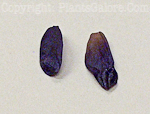 In the forest, seeds from
trees drop to the ground and become nestled in the
organic matter that has accumulated over the years.
Often, to be successful in this environment, these seeds
must wait until the following spring to germinate. So,
plants have developed a dormancy mechanism to accomplish
this feat.
In the forest, seeds from
trees drop to the ground and become nestled in the
organic matter that has accumulated over the years.
Often, to be successful in this environment, these seeds
must wait until the following spring to germinate. So,
plants have developed a dormancy mechanism to accomplish
this feat.
To artificially break
this type of dormancy, the propagator has to first of
all determine the precise mechanism used by a particular
species. Tests by universities, U.S. Department of
Agriculture and others have
resulted in volumes on the particular needs of the many,
many species of perennials. Reference books and websites
can fill you in on the requirements for your species.
In general,
stratification requires one or sometimes two treatments
of cold temperatures combined with moistness. This is
meant to replicate the conditions found in the forest
flower in the winter.
For the home propagator,
artificial stratification involves the following steps:
-
Soak some peat
moss in water.
-
Squeeze out as
much water as you can with your hands.
-
Put an inch layer
of the moist peat moss in the bottom of a
plastic bag or other such container.
-
Spread the seeds
on top of this layer.
-
Put another inch
of moist peat moss on top of the seeds.
-
Place the seal
container in a refrigerator at around 40 degrees
F.
-
Leave it there
for the amount of time required for that
particular species.
-
After the
required period (or periods) have been
completed, take the seeds and plant them as you
would any other seed.



